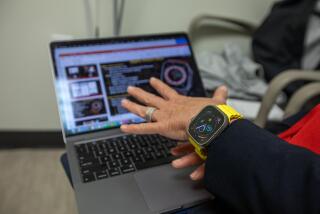The Doctor Will See You Now--on TV
PORTLAND, Ore. — In one of the worst winters in the history of North Dakota, where the National Guard is plowing snowy highways piled higher than 18-wheelers, doctors are having no trouble connecting with their patients.
They just sit in front of an interactive TV set, or dial up a computer, and practice telemedicine, the technology that is changing the way health care is managed across rural America.
It made a world of difference to Cindy Gall, whose 3-year-old daughter, Allison, suffers from a congenital heart defect and needed frequent visits to a specialist 100 miles away in Bismarck.
“We made many, many long trips in the dark, in the cold, in the snow, 100 long miles with nothing in between,” Gall said.
With two other children, a full-time job and a long-haul trucker husband who is frequently on the road, Gall was exhausted until the doctor in her hometown of Wishek helped bring telemedicine to the community.
Gall now takes her daughter down the street to Dr. Don Kosiak’s office. He relays lab work and X-rays by computer and consults via video hookup with the cardiologist in Bismarck.
The promise of telemedicine, its supporters say, is higher-quality health care at lower cost for rural doctors and patients. Much of the savings comes in reduced travel costs for patients and doctors and in elimination of duplicate hospital services.
“We’re talking close to $1 million in travel savings last year for us,” said Thelma McClosky Armstrong, director of the Eastern Montana Telemedicine Network in Billings.
Some of the technology can be as simple as a standard laptop computer, a modem and a digital camera, said Dr. Douglas Perednia, a dermatologist who is leading a statewide telemedicine project at Oregon Health Sciences University in Portland.
A rural doctor can take a digital picture of a patient with a skin problem, and use the laptop connected to a standard phone line to transmit it to a dermatologist in Portland. The specialist can then simply call the rural physician with the results, saving time, travel and data-line costs in a state with only four dermatologists practicing east of the Cascade Range.
A General Accounting Office report issued Feb. 14 found that 35 federal departments or independent agencies, 10 state governments and numerous private groups have sponsored hundreds of telemedicine initiatives in at least 40 states.
Perednia founded the national Assn. of Telemedicine Service Providers in Portland in January to help hospitals and clinics find the right equipment and companies to set up remote health-care systems.
“There’s no coordination right now,” Perednia said. “A very simple place to start is consent forms. There are no standard consent forms for telemedicine.”
The main obstacles are paying for costly telephone data lines, finding the computer equipment best suited to telemedicine, establishing interstate medical license requirements and establishing fees for electronic consultations.
McClosky Armstrong said local high-speed telephone data service costs $200 a month in Billings, but it costs $1,900 a month to connect to Miles City, 120 miles away.
The costs add up for a service area that is bigger than the state of Pennsylvania, and it is very costly for telecommunications companies to set up infrastructure with few customers to pay the bills.
Dr. Jim Logan was on the leading edge of telemedicine as chief of medical operations for NASA during the 1980s. He now is a consultant in his native Oklahoma, where he spends much of his time advising doctors and hospitals on getting the most for their technology budgets.
He predicts that many large hospitals will become dinosaurs unless they learn to use telemedicine to export their services and expertise efficiently and inexpensively.
He noted that rural doctors in South Dakota have begun using a group of radiology specialists in Lincoln, Neb., to read X-rays because it’s more cost-efficient than sending patients to a local hospital.
“Telecommunications is to large medical facilities what gunpowder was to medieval fortifications,” Logan said.
Sens. Ron Wyden (D-Ore.) and Kent Conrad (D-N.D.) have introduced bills to promote telemedicine.
Wyden’s bill would set minimum requirements for Internet access for health-care providers in rural areas, and Conrad’s bill asks the secretary of Health and Human Services to study licensing and make a recommendation.
Both bills would require Medicare reimbursement for telemedicine consultations by a specialist, which most doctors have been providing free--a practice they say they cannot continue as demand grows.
“Medicare already pays for these consultations if they’re in person,” Conrad said. “Why not pay for them over the air so you can save people from traveling 100 to 200 miles? It only makes sense.”
More to Read
Sign up for Essential California
The most important California stories and recommendations in your inbox every morning.
You may occasionally receive promotional content from the Los Angeles Times.










